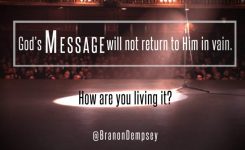Band, Leaders, Players, Worship Leading, Worship Planning
Overwhelmed By Over-playing (Show #56)
4 min read
Is it overwhelming?
When it comes to your band’s sound, is it just too much? Everyone is constantly playing, every instrument is being used and most often, the people in your church are talking about the sound as well.Is this good or bad? As a worship team, what are some things we can do to peel back the sound? Maybe break things up a bit, inspire some creativity of parts and make things musical again.
In keeping with our week’s theme #Overwhelmed we will look at the song (video below) “Overwhelmed,” by Big Daddy Weave (Michael Weaver and Phil Wickham) In this post, we will also address five things that you need to know to make your music more colorful and creative.
1. Make the Tough Call
Psalm 33.2 says “Praise the LORD with the harp; make music to him on the ten-stringed lyre.” Learn to select the right instruments. Before we make music, make the tough call in using the right instruments for the song. It may begin with guitar, the song may start with piano or drums. One thing is clear, every instrument has a specific voice and part. They must be heard as in a symphony, not in a cacophony.
As you plan, arrange or rehearse your worship team, call for the right instruments to play the right parts. As each of us are called to faith, each instrument is called to make music.
2. Choose wisely…your parts.
Speak into your team and encourage the perspective of playing parts. Ask for the guitar player to lay out in Verse 1. Start off the song with a light piano melody. Have the bass come in slowly – playing at a high register. Encourage the drummer to play a specific feel (if you don’t know how to speak drum, learn about the instrument as well as patterns, parts and groove).
This comes from listening to what is going on in the music. Most don’t have the patience to sit and listen to the entire song. Look at the chart as you listen to the music; then you can hear and see what is happening together. The notes will jump off the page.
You will begin to hear certain parts and the voices of instruments (same for vocals)
“The band’s job is to support the vocals, in helping the church worship.” @BranonDempsey
3. Create Textures: “Overwhelmed” Music Example
By listening to the music, pick out what is happening in each section as we study the tune: “Overwhelmed.” Pay attention to the recording as an example. Map-out what you’re hearing and understand how the parts are being played. Learn to create texture: musical rhythms, dynamics and chordal progression that give shape to the song. Intro:
The song’s meter is in 6/8. It begins a very soft woodwind patch from the keyboard – hold sustaining notes. After a few bars the kick drum enters in a quarter beat style: 1, 2, 3, 4, 5, 6 Also, there is a combination of other Mellotron flutes (you can also use soft electric piano patches). The intro has a very celtic/strawberry fields sound, first made popular by the Beatles.
Next, we have movement in the acoustic guitar section playing eighth notes: 1 & 2 & 3 & 4 & 5 & 6 & Quarter note triplets are played in the electric piano part: 1 – 2 | 1 -2 | 1 – 2 | 1 – 2 All of this works together nicely to provide rhythmic contrast and harmonic energy. The electric piano part seems to have a lift/upbeat quality, as the guitar and other keyboard parts anchor down the rhythm.
Two main sections to study:
Verse: The vocal is very strong as it sings over the instrumental texture. Notice how the dynamic of the instruments stay at a low level to support the lyric, yet it maintains energy without dragging. The electric piano lays out, and the guitar, kick drum and soft mellotron instruments continue. This section slightly builds to the chorus.
Chorus: Immediately at the words “I delight myself in You…” the bass and low toms enter this section, providing a thunder like feel. Not too heavy, but just enough to provide some low end and depth. The vocal sits very nice in between the texture above. Notice how the musical activity in the band does not overpower the vocals. In fact, they compliment and highlight what the vocals are doing.
This is accomplished by each instrument maintaining control and good use of volume. Again, while the guitars and drums are playing eighth notes, notice how all the notes are played evenly. From note to note, they are smooth, uninterrupted and consistent. Most players will tell you this is a very difficult technique to master.
4. Learn to Build the Music with Dynamics
Interlude: this section is a recap of the intro. However, we have a double overlay of keyboards playing the same rhythms as the acoustic guitar, but in a melodic pattern – arpeggiating chords. Verse Two: Drums pick up with the bass. Their parts are played about every other bar – giving the instruments room to breathe – filling out the space in the verse. Verse two is now cut a bit short as the music segues into the Chorus.
Chorus Two: the whole band opens up with a wider dynamic. You can hear the organ in the background providing a sense of strength and bright color. The snare drum also enters providing a large backbeat that gravitates the 6/8 feel. Notice, this is the first time the snare (drums) is playing this kind of groove / along with the bass. The song has arrived at a certain point that justifies this kind of momentum. If the drummer and bass started the song out in this same way in the intro, dynamically, they would have no more room (threshold) to go.
5. Strive for dynamics
Interlude 2: again another recap, plus, a snare march to build intensity, leading up to the bridge. Bridge: Much of the band drops out. The marching snare pattern continues, but with the snares off. The acoustic guitar continues as well. This section has a much more organic and earthy sound to change up what was previously heard in the Chorus. Next in the bridge, the drums come back in with the familiar pattern from the Chorus.
The bass and keyboards, as well as strings, build a background wall of sound. Suspended cymbal enters with a crescendo – all leading back to the final push of the Chorus. Ending: is a bit of a recap of the bridge section. The chord progression from the intro is played over the drum/tom groove.
There’s an overlay of vocals / repeating sections of the lyrics in the chorus + a very nice background children’s choir. The drum groove builds towards the end, along with one big strike of the toms – finalizing the song.
Theme of the week:
#Overwhelmed
In conclusion:
When we select the right instruments, parts, arrangement and use the right dynamics to the song, the piece of music becomes something more than notes on a page.
It becomes a living, breathing sound that is overwhelmingly beautiful. People can hear themselves sing also, because the music supports the lyrics. Your team learns a few more tools to be creative and to elevate their skill.
Also, your music will be fresh, powerful and less redundant. Best of all, as a team, you are blessing the Lord and His Church to: “Sing to the LORD a new song; Sing to the LORD, all the earth.” #Psalm 96.1
@BranonDempsey @worshiptt
WATCH SHOW #56!
 How can your worship team benefit from learning new vocals techniques, creative ideas for your band and be inspired to transform your ministry into worship unity? Get motivated. Get a custom WeekendWorkshop that comes to you!
How can your worship team benefit from learning new vocals techniques, creative ideas for your band and be inspired to transform your ministry into worship unity? Get motivated. Get a custom WeekendWorkshop that comes to you!Copyright 2016 Worship Team Training®










